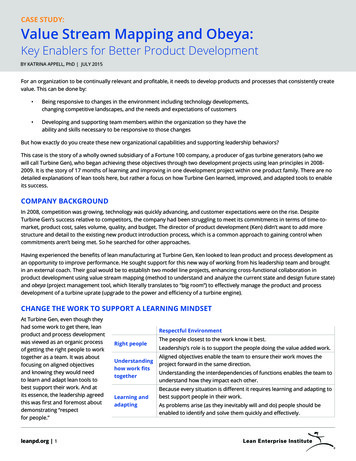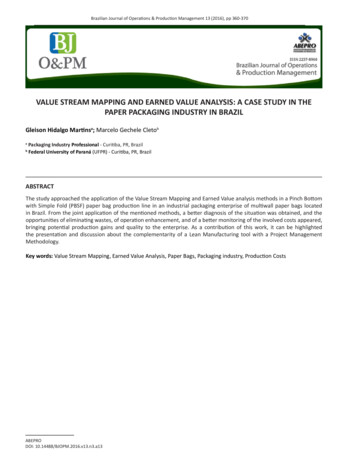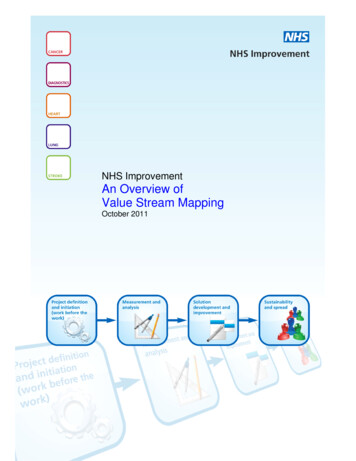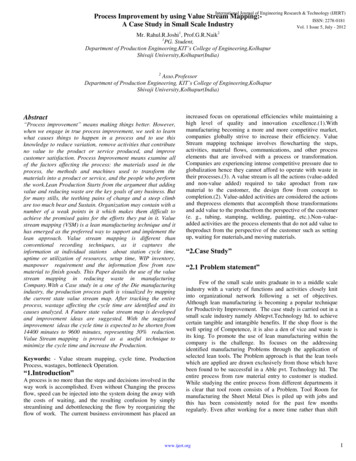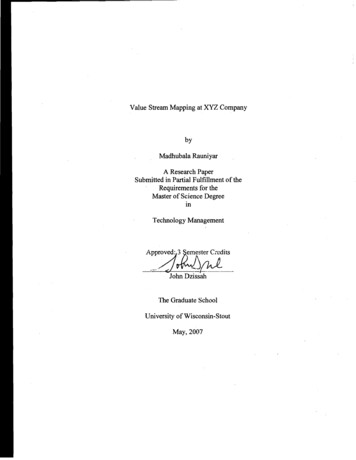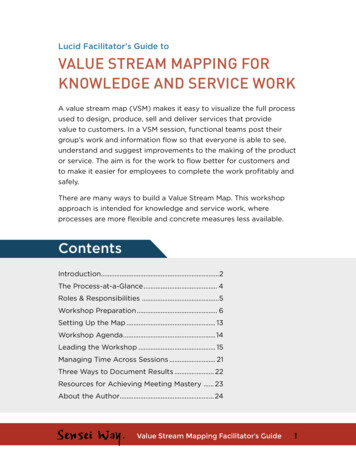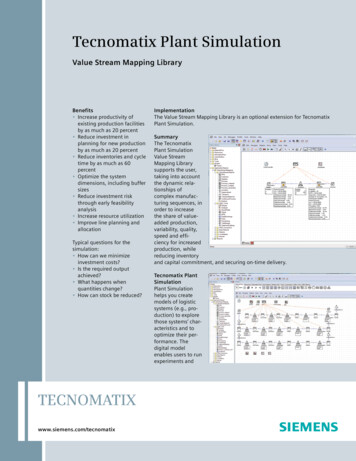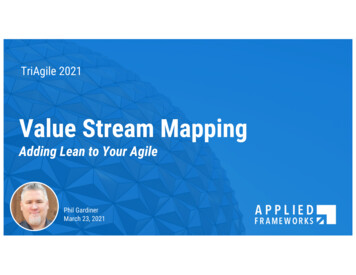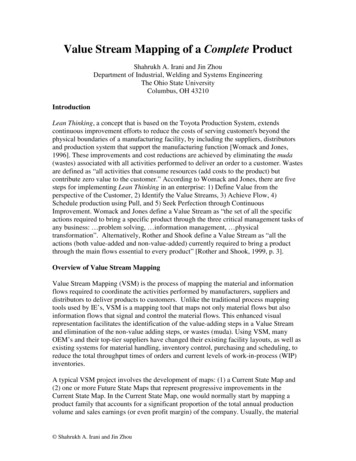
Transcription
Value Stream Mapping adapted to HighMix, Low-Volume ManufacturingEnvironments2012:120JUAN MANUEL ARAYAMaster of Science ThesisStockholm, Sweden 2011
VALUE STREAM MAPPING adapted toHIGH-MIX, LOW-VOLUME ManufacturingEnvironmentsJuan Manuel ArayaMaster of Science Thesis INDEK 2011:xKTH Industrial Engineering and ManagementIndustrial ManagementSE-100 44 STOCKHOLM
Examensarbete INDEK eKontaktperson{Namn}{Namn}SammanfattningNyckelord
Master of Science Thesis INDEK sor2011-month-day{Name}{Name}CommissionerContact person{Name}{Name}AbstractThis research work proposes a new methodology for implementing Value Stream Mapping, inprocesses that feature a High-Mix, Low-Volume product base. The opportunity for adapting themethodology singularly for these types of environments was identified because implementingValue Stream Mapping as proposed in Learning to See features several drawbacks whenimplemented in High-Mix, Low-Volume. Although Value Stream Mapping has been proven toenhance many types of processes, its advantages are shrunk if they are implemented in HighMix, Low-Volume processes.High-Mix, Low-Volume processes are types of processes in which a high variety of finishedgoods are produced in relatively low amounts. The high variety of finished goods causesseveral complications for the implementation of flow. The difficulties that prevent the flow arethe following: The variance in the products: With hundreds, or sometimes thousands of possiblefinished goods, the number of products causes a non-repetitive process. The variance in the routings: All of the products that are produced can havecompletely different process routings, or order of stations it has to visit. This makes theapplication of production lines quite difficult. The variance in the cycle times for each process. Each of the different products canhave completely different capacity requirements at a specific machine, which limits thepredictability of the process.This purpose of the thesis is to gather the best practices for controlling and improving High-Mix,Low-Volume processes and merge them with some innovative ideas to create an inclusiveValue Stream Mapping methodology which is better fitted with the types of complications inHigh-Mix, Low-Volume environments. In parallel, the methodology is tested with the company:Boston Scientific, in their Ureteral Stents manufacturing process. The real-life experimentationwill allow for the fine-tuning of the methodology, in order to truly create impact in the process.
DedicatoryAlthough one person, the inspiration, knowledge, and methodology wrote this master thesis wasreally a team effort with many people aiding directly, or thru inspiration.Firstly, I would like to thank the staff at the Boston Scientific manufacturing plant. I would like tothank Enrique Saborio who initially contacted me with this great opportunity, and suggested theuse of Value Stream Mapping as a possible project to develop. I thank Eric Tagarro, mysupervisor for providing guidance, support, friendship, and most of all for the trust and freedomto have full control of the project. I would like to thank Juan Miguel Gomez for assisting me inevery initiative, and the rest of the production team: Ernesto Trigueros, Juan Jorge Solano,Karoline Arguello, Nehemias Venegas, Ana Villalobos, Melissa Fernandez, and KathyaCenteno. The Industrial Engineering department consisting of Jean Paul Cerros and TatianaAlvarado with whom I worked side-by-side. I would like to thank the rest of the US/DCproduction unit: every single person helped me with a situation at one time or another. I wouldlike to thank Rocio Quiros at HR, for patiently helping me and guiding me through thebureaucratic process with the universities. I would like to thank everybody at Boston Scientificwhich I consider a great company, with an amazing, talented, and fun workforce.I would like to thank my IMIM family, including all of my classmates. They were the source ofendless inspiration, competition, but most of all, endless fun in and outside the classroom. Iconsider all of them true lifelong friends with whom I look forward to sharing many more goodtimes. I would also like to thank the IMIM Coordinators for all of their diligent efforts to providethe best experience possible.I would like to thank Professor Alberto Portioli for his interesting class in Lean Manufacturing,which provided with the initial knowledge base for the project. Also the rest of the professorsfrom IMIM, I used topics from every single class in order to develop my project. Thank you forgiving us this great knowledge.I would like to thank all of the innovative Lean Leaders who have written wonderful books, andhave established an easy-to-understand methodology, proven to enhance business processes.Lastly, I would like to thank the most influential people in my life, my parents. They haveunconditionally provided me support in everything I do, including the means to join the IMIMprogram, the best experience of my life. Every decision I take is based on their love andguidance. I also thank the rest of my family, especially my grandparents. Much love andblessings!
TableofContentsValueStreamMappingadaptedtoHigh- ‐Mix,Low- .181.8.2Processes- fReference.364.8LiteratureReview.38
reams.454.8.5Made- ‐to- nManufacturingPrinciplesinaHigh- ‐Mix,Low- nginLessManualProcesses.959Bibliography.96
1 Introduction1.1 ProblemDefinitionThe concept of mapping a process for visualization has long been well known in manydifferent areas and organizations. The idea was translated into manufacturing almost as earlythe beginning of scientific management. With the introduction of Lean Manufacturing, newdimensions of tools where added to regular process mapping. In addition to simply visualizingthe process, Value Stream Mapping methodology proposed a specific plan to use thevisualization, and implement Lean Manufacturing through a series of steps. By proposing thesespecific tools using the mapping, the authors had to make a series of assumptions about aprocess. This new methodology was called Value Stream Mapping and was originallypublished in the book Learning to See by Mike Rother and John Shook. Although someaspects of the methodology were left openly for interpretation, other tools were proposed toimprove a specific type of processes. As such, some unwritten assumptions are made by ValueStream Mapping methodology proposed in Learning to See such as: That cycle times in each process are constant per product, or even product families. That product variations can easily be separated into families. That pull systems will always be the way to reduce the most waste after flow (Flow if youcan, pull if you must). That routings are constant. That machine dedication rate is constant for a product family.These assumptions made in Learning to See, leave a lot of confusion open for processesthat do not fit these common underlying assumptions. Such is the case with High-Mix, LowVolume manufacturing environments. Such environments display the following characteristics: Many different product numbers produced in relatively low quantitiesMany different routings for all of the productsJob Shop manufacturing environments.High variance within cycle times depending on the product type.High variance in demand of each different part numberAs such, there needs to be a different methodology that extracts all of the positive aspectsthat Value Stream Mapping methodology can bring, and combine it with many other tools thatexist outside to optimize High-Mix, Low-Volume manufacturing environments. Regarding LeanManufacturing, there are several different toolsets, which have tackled the optimization of aHigh-Mix, Low-Volume manufacturing environment. However, most of these tools have verybriefly and ineffectively tackled the subject. There are many methods used by manufacturingmanagers to minimize waste, and properly control High-Mix environments. However, a tool hasnever been developed that compiles these methods. Even more rarely have these tools beencombined with traditional Value Stream Mapping methodology to provide a brand newconceptual and complete approach to improve such processes. Although the publicationsrelated to High-Mix, Low-Volume manufacturing are numerous, most of them do not get past a“tip book” which provide ways to improve very specific situations. In addition, many of thesepublications do not propose innovative ideas to stretch Lean Tools to function in High-Mix.They simply propose widely known and acknowledged Lean Tools such as 5S, Standard Work,and Pull Systems, adding very little value to the general knowledge of controlling the beast that
is Job Shop environments. This forces supervisors, Industrial Engineers, and managers ofsuch environments to try to control High-Mix environments doing three different things: Constantly searching for new tools to improve the process. Focusing on one single source of knowledge, thus having an incomplete view of thepossibilities that exist to improve the process. Ineffectively trying to implement only traditional Lean Tools, which might not be meant tooptimize High-Mix, Low-Volume environment. Disengage from a central management philosophy, and control the productionprocesses on an instinctual basis, which turns their responsibilities into constantly puttingout fires. This might even deteriorate the process, thus discouraging managers fromusing Lean or VSM.All of the above are augmented by the fact that with the instability of High-Mix, Low-Volumeprocesses gives very little free time for managers and engineers to focus on continuousimprovement. Most managers do not even understand their own production floor, or thedynamics of it. Therefore Job Shop divisions in companies are left as the “black sheep” of theplant, and the focus shifts to containing issues, rather than completely transforming processesinto productive manufacturing units. Job Shop environments can often be interpreted as a blackbox, in which orders enter with very little visibility or control, and do not get that visibility untilthere is a quality issue, or the order is complete. In the case where the order is complete, it canoften be indefinable. The lead time is also extremely difficult to estimate due to the lack ofvisibility of the floor. This lack of visibility and control that happens in High-Mix, Low-Volumemanufacturing is the source of many of the problems that can arise when implementing LeanInitiatives. Almost all methodologies and literature currently available completely ignore thevisibility and control aspect of the production process. Therefore, by not attacking one of themain sources of waste and problems in the productions floor, managers can fall short. Theymight unsuccessfully try to implement tools such as Kanban, continuous flow, and level demandwith no regards to the effects that it can have on a Job Shop, or the dedication it takes toimplement them.All of the above issues are of course very important. Yet they have even more significantweight in present times. In the era where mass customization is becoming a buzzword, andconsumers are extremely demanding on the level of variety that needs to be available, thereneeds to be an ideology to handle these issues. In all industries, High-Mix, Low-Volume isbecoming the norm. Gone are the days of Henry Ford when consumers could not choose thecolor of their car. Consumers want control of nearly all characteristics of a product, into thepoint where they are becoming part of the design team. In addition, consumers want all of thefreedom inherent in variety with the same level of speed, quality, and price that they have gottenused to with high-volume products. In this stance, managers should seek to go beyond LeanManufacturing methodologies, and into more flexible systems such as Quick ResponseManufacturing, Agile Manufacturing. They need to become knowledgeable in all methodologiesto custom design the right tools to fit their process and provide the custom products thatconsumers demand. That is why there needs to be an effective, easy to understand, completemethodology that can be used aggregately to optimize High-Mix, Low-Volume environments.This research work seeks to find through books, publications, and companies to compilethe best methods that can be applied to optimize High-Mix, Low-Volume environments, Inaddition, through the Scientific Method, new tools will also be proposed. The final toolset will
then be compiled into an easy to use “mapping” tool similar to Value Stream Mapping tocontinuously improve processes. This tool can provide managers in one document with thestate-of-the art toolset to tackle High-Mix, Low-Volume issues.1.2 PurposeThe research work is focused on compiling all of the best ideas and research currentlyavailable for the control of a High-Mix, Low-Volume manufacturing environment. It obtains thebest characteristics of many different sources, and creates a merger with Value StreamMapping. As defined in the problem, Value Stream Mapping might discourage manyinexperienced managers when they face situations not covered regular Value Stream Mappingapproaches. Regarding High-Mix, Low-Volume production, there exist many different tools andmethodologies to improve on such processes, yet there are few and far between. There is not asingle piece of literature that encompasses a solution and tips for most problems in a High-Mix,Low-Volume manufacturing environment. In addition, most toolsets proposed are contradictoryto each other, not thorough enough, or provide too much academic detail to be understoodeasily by today s top managers. Therefore, a new methodology must be created to better thecontrol of High-Mix, Low-Volume manufacturing. By aggregating all of the knowledge on thesubject, and converting it into an implementation tool such as Value Stream Mapping, managerscan have a complete and open solution to many of their problems. It will share many of thecharacteristics of Value Stream Mapping, yet it will eliminate many of the flaws that it creates inHigh-Mix atmospheres. Although it is technically impossible to create an easy-to-use tool thatemphasizes on every single possible issue faced in a High-Mix, Low-Volume manufacturingenvironment, there can be advances into a tool which encompasses at least most of the majordilemmas. The tool will aim to optimally minimize waste, however it will also include toolsetsoutside of the Lean Manufacturing realm. Tools such as POLCA cards from Quick ResponseManagement philosophies, Just-in-Time, and experimental new tools will be incorporated intothe Value Stream Mapping methodology. Like Value Stream Mapping, it will focus on creating acurrent state of the process which best encapsulates the High-Mix, Low-Volume manufacturingfloor, and having a series of implementation steps in order to best organize the minimization ofwaste.Such a tool is highly important for the current, and coming years. Due to theincreasing choosiness of consumers, High-mix, Low-Volume manufacturing is slowly becomingthe prevalent standard in many manufacturing environments. Consumers constantly want tohave a greater variety of possible products at the same quality and price as before. Therefore,there must be an easy to use methodology to aggressively reduce waste in order to meet thesetargets set by the costumer. Like many other Lean Manufacturing tools, it must be easy-to-useand easy to understand. It must come as a “solutions” manual package that both provides aneasy way to balance and anticipate improvement initiatives, while still providing enoughacademic value to better processes.The methodology proposed in this research work will seek to accomplish all ofthose goals. It will create value by eliminating waste that is prevalent in High-Mix, Low-Volumemanufacturing. At the same time, the thesis will be conducted in parallel with an internship withmedical devices manufacturer, Boston Scientific. Most proposed ideas will be thoroughly testedin a real production floor. The tools that have can still add value will be added to the ValueStream Mapping methodology, while some tools will not make the cut to better reduce waste.By doing this, the current knowledge base on the implementation of Lean Manufacturing for
High-Mix, Low-Volume manufacturing environments will be augmented. Managers can turninto a single source for the beginning of improving a High-mix, Low-Volume process, similarly inthe way that they use Learning to See to implement Lean manufacturing.1.3 DelimitationsAlthough Value Stream Mapping is a tool meant to optimize the entire process inside of afacility, due to certain limitations imposed in the nature of the Boston Scientific, the companywhere it was experimented, all aspects of Value Stream Mapping could not be questioned. Thevarying difficulties that different facilities face amplify this issue. For those reasons, theresearch and experiments were focused mostly on the manufacturing process, or the process totransform the unprocessed extrusions into ureteral stents. Although the materials procurementand shipping activities were mapped out, specific tools used to optimize the operations of thesewere not researched. Another reason why the optimization research was mostly limited to themanufacturing process was because of the company structure inside Boston Scientific issegmented. Although all experiments were done as part of the Production organization, thereare many other organizations that influence the product before and after production. Whenentering the plant, the product and its flow are influenced and handled by the followingorganizations: Receiving / Supply ChainWarehouseSupermarketProduction (Tipping – Boxing)Quality ReleaseShippingFocus of ResearchTrying to implement experimental initiatives in all areas would prove extremely difficultgiven the separation of the organizations. In addition, all other organizations outside ofproduction are concerned with many more production units than Ureteral Stents, which wouldamplify the consequences. That is why the Mapping of the Value Stream is focused onProduction.The research also goes outside of the regular scope of Value Stream Mapping in that ishighly focused on improving the control and visibility of the open production orders in the floor.Given that in High-Mix, Low-Volume job shop environments there are a plethora of open ordersat a time, the production team had many difficulties improving the visibility and the control of theorders. FIFO was not being followed in the WIP between stations and prioritization was poorlyfollowed. When an order was in backorder status, it was very hard to find the order on the floorin order to optimize it. There was no visibility by the production team of the orders whatsoever.While lean is associated with the relentless elimination of waste, the theme of production controlis seldom tackled given that it is assumed that the orders are run as a production line, whicheliminates waste. Yet, given the nature of job shop environment where orders are run inbatches, control is a big issue. While it is hard to quantify the financial savings given by animprovement in control, having visibility will make it easier to see waste. If there is no visibility,there is not visibility into the waste. In addition, by being unable to control the prioritization ofproduction orders, a great variation in lead time occurs which indicates an overall lack ofprocessing control. In addition, it causes both backorders, and customers being wronglydeceived by receiving orders that are released very quickly. So the research in the work will
seek to explore production control methodologies both covered in Lean ideals, and outside ofLean. In addition, several innovative themes are explored such as the use of Electronic WorkOrder Boards, and Prioritization Unit Numbers.Several Lean and Value Stream elements were left out of the research. In particular, theconcept of Pitch, or releasing work into the production floor at a constant pace is ignored forseveral reasons. Due to the high variance in lot sizes, releasing work into the production floorat a constant pace would create disorder instead of order. In addition, due to the high variancein the routings of the products, and in variety of cycle times depending on each product numberon the family, the pitch would have to vary highly to be optimal. Although using pitch to controlthe production floor might be possible, it requires its own specific research goals.The focus of the research also leaves out much of the material, or component processmapping. This is simply due to the fact that the manufacturing process of Ureteral Stents ismostly a transformation process, so it does not use many components in its final product. Thecomponents used are also fairly standard and aggregate throughout all of the product types,which mean that they do not face the same challenges as the extrusions, which are transformedwith a high-mix, low-volume production environment. The only major subassembly that isslightly processed before it goes into the positioner, or the tube used to facilitate the placementof the ureteral stent into the urethra. Even being the only major subassembly, it only goesthrough one process that is crimping. This means there is not too much to delve into in terms ofcontent.In terms of delimitations, the only other one is that the research is solely focused on theBoston Scientific Ureteral Stents line. This means that the experimenting has been made in avery specific system, and thusly it will probably not cover every single issue that could beencountered in a High-Mix, High-Volume manufacturing environment. The solutions proposedhave been those, which optimize the Ureteral Stents process. This also means that thesolutions are meant for mostly manual processes. The manufacturing process for UreteralStents is mostly manual, except for the oven forming process. If a process was highly moredependent on machines, a different kind of tool might be needed.1.4 TargetGroup:The research is intended to bring value to two distinct groups of people. Firs
Value Stream Mapping as proposed in Learning to See features several drawbacks when implemented in High-Mix, Low-Volume. Although Value Stream Mapping has been proven to enhance many types of processes, its advantages are shrunk i
